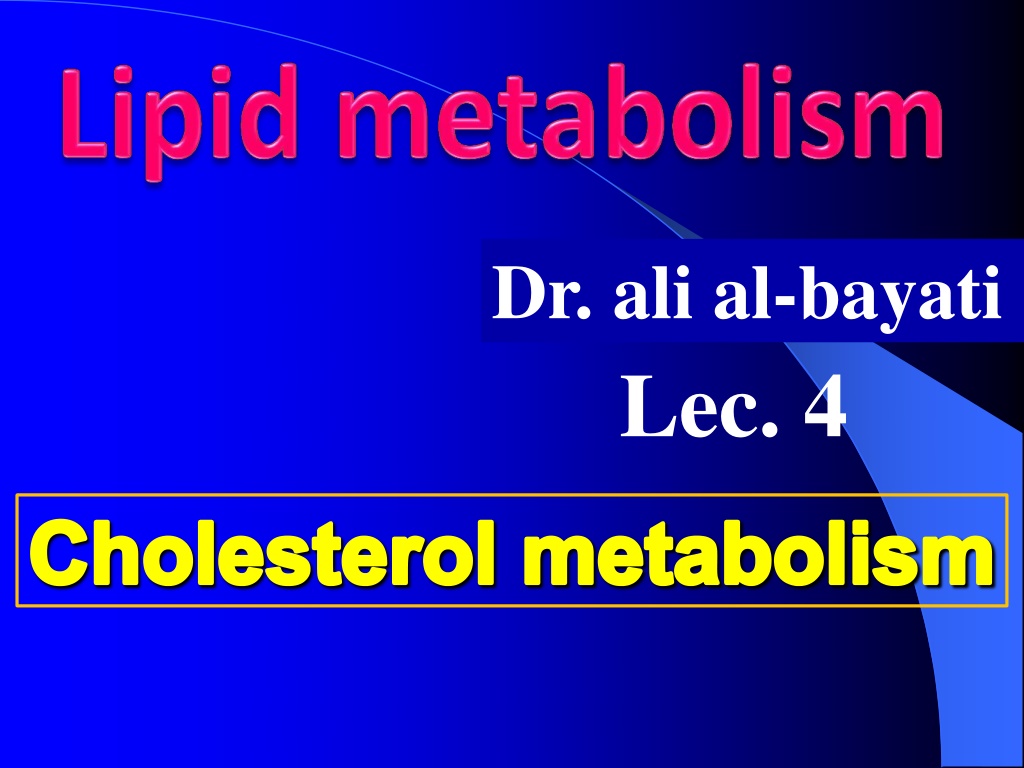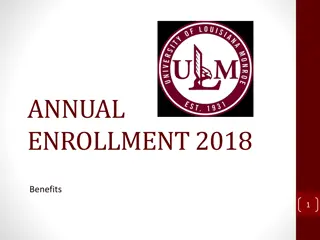
Understanding Cholesterol Metabolism in Animals
Learn about the functions, structure, sources, absorption, and biosynthesis of cholesterol in animals. Discover how cholesterol is essential for various biological processes and its role in health.
Download Presentation

Please find below an Image/Link to download the presentation.
The content on the website is provided AS IS for your information and personal use only. It may not be sold, licensed, or shared on other websites without obtaining consent from the author. If you encounter any issues during the download, it is possible that the publisher has removed the file from their server.
You are allowed to download the files provided on this website for personal or commercial use, subject to the condition that they are used lawfully. All files are the property of their respective owners.
The content on the website is provided AS IS for your information and personal use only. It may not be sold, licensed, or shared on other websites without obtaining consent from the author.
E N D
Presentation Transcript
Dr. ali al-bayati Lec. 4 Cholesterol metabolism
INTRODUCTION Cholesterol is the major sterol in the animal tissues. Cholesterol is present in tissues and in plasma either as free cholesterol or as a storage form, combined with a long-chain fatty acid as cholesteryl ester. In plasma, both forms are transported in lipoproteins Plasma low-density lipoprotein (LDL) is the vehicle of uptake of cholesterol and cholesteryl ester into many tissues. Free cholesterol is removed from tissues by plasma high-density lipoprotein (HDL) and transported to the liver, where it is eliminated from the body either unchanged or after conversion to bile acids in the process known as reverse cholesterol transport .
Cholesterol Functions & structure Membrane component Precursor to Bile acids Vitamin D Steroid hormones 1. All steroids have cyclopentanoperhydrophenanthrene ring system (Fig.). It is a fused ring system made up of 3 cyclohexane rings designated as A, B and C and a cyclopentane ring D. 2. Total 27 carbon atoms. 3. One OH group at third position which is characteristic of all sterols. The OH group is beta-oriented, projecting above the plane of ring. 4. Double bond between carbon atoms 5 and 6. 5. An eight carbon beta oriented side chain attached to 17th carbon.
Sources Cholesterol can both be synthesized endogenously and obtained from the diet. significant amounts of cholesterol only occur in meat, eggs, and milk products; plants and mushrooms contain other sterols but very little cholesterol. The fact that vegetarians survive tells us that our capacity to synthesize cholesterol suffices to cover our need for cholesterol entirely. Like other lipids, cholesterol has low water solubility & requires special mechanisms and vehicles for transport. In the bloodstream, both cholesterol and triacylglycerol are transported within lipoproteins.
Absorption of Cholesterol Cholesterol absorption in the duodenum and proximal jejunum. Western diet, 1\4 cholesterol is from the diet; the bulk comes from the bile and cells sloughed intestinal epithelium. cholesterol is incorporated into bile salt micelle and absorbed into the mucosal cell. There is a specific protein which facilitates the transport of cholesterol into the mucosal cell from the micelle Inside the mucosal cell, cholesterol is reesterified by acyl-CoA: cholesterol acyltransferase (ACAT) to form cholesterol esters, and incorporated into chylomicrons.
Biosynthesis of cholesterol (De novo Synthesis ) Major sites are liver, adrenal cortex, testes, ovaries & intestine. All nucleated cells can synthesize cholesterol, including arterial wall. The enzymes involved in the synthesis of cholesterol are partly located in endoplasmic reticulum & partly in cytoplasm. Requirements of cholesterol biosynthesis Acetyl CoA provides all carbon atoms. All the 27 carbon atoms are derived from acetyl CoA &18 acetyl Co A are required. Reducing equivalents are supplied by NADPH. 16 moles of required. ATP provides energy. 36 moles of ATP
Steps of cholesterol biosynthesis Step 1. Synthesis of HMG CoA ( -hydroxy -methylglutaryl CoA) Step 2. Formation of Mevalonate Step 3. Production of isoprenoid units Step 4. Synthesis of squalene Step 5. Conversion of squalene to cholesterol
Synthesis of HMG CoA (-hydroxy -methylglutaryl CoA) Two moles of acetyl CoA condense to form acetoacetyl CoA. Another molecule of acetyl CoA is then added to produce HMG CoA. These reactions are similar to that of ketone body synthesis. The two pathways are distinct. Ketone bodies are produced in mitochondria while cholesterol synthesis occurs in cytosol. There exist two pools of HMG CoA in the cell. Two isoenzymes of HMG CoA synthase are known. The cytosomal enzyme is involved in cholesterol synthesis whereas the mitochondrial HMG CoA synthase participates in ketone body formation. 6C
2. Formation of Mevalonate HMG CoA reductase is the rate limiting enzyme in cholesterol biosynthesis. This enzyme is present in endoplasmic reticulum & catalysis the reduction of HMC CoA to Mevalonate. The reducing equivalents are supplied by NADPH.
3. Production of isoprenoid units (activated 5 carbon intermediates) Activation accrue by addition of phosphate group In a three step reaction catalyzed by kinases, Mevalonate is converted to 3- phospho 5-pyrophosphomevalonate which on decarboxylation forms isopentenyl pyrophosphate (lPP). It is isomerizes to dimethylallylpyrophosphate (DPP). IPP & DPP are 5-carbon isoprenoid units.
4-Synthesis of Squalene Squalene (C30) is synthesized from six molecules of Isopentenyl Pyrophosphate (C5) and the reaction sequence is- C5 C10 C15 C30 This stage in the synthesis of cholesterol starts with the isomerization of isopentenyl pyrophosphate (lPP) to dimethylallyl pyrophosphate (DPP). (DPP) then condensed with (lPP) to form the ten-carbon intermediate geranyl diphosphate. A further condensation with (lPP) forms farnesyl diphosphate C15 . Two molecules of farnesyl diphosphate condense at the diphosphate end to form squalene.
5- Conversion of squalene to cholesterol (Cyclization) Squalene undergoes oxidation to form squalene epoxide. Cyclase converts it to 30 carbon lanosterol. It is the first steroid compound synthesized. Then a multistep process with a series of about 19 enzymatic reactions. Most important reactions: Reducing the carbon atoms from 30 to 27. Shift of double bond from C8 to C5 Removal of 2 methyl groups from C 4 and 1 from C14
Regulation of Cholesterol synthesis Cholesterol biosynthesis is controlled by the rate limiting enzyme HMG-CO A reductase 1. Feedback control: The end product cholesterol controls its own synthesis of the enzyme by a feedback mechanism. Increase in the cellualar concentration of cholesterol reduces the synthesis of the enzyme by decreasing the transcription of the gene responsible for the production of HMG CoA reductase. 2. Hormonal regulation: The HMG CoA reductase exists in two interconvertible forms. Insulin and thyroid hormones Increase HMG CoA reductase activity The dephosphorylated form of the enzyme is more active, phosphorylated is less active. Hormones exert their influence through cAMP
Glucagon and glucocorticoids decrease HMG-CoA reductase activity Inhibition by drugs: The drugs Compactin and lovastatin, mevastatin, simvastin are competitive inhibitors used to decrease the cholesterol. HMG CoA reductase is inhibited by bile acids. LDL transports cholesterol from the liver to peripheral tissues. HDL transports cholesterol from tissues to liver
Compactin, lovastatin [Competitive inhibitors] Mevastin, Simvastin HMG CoA _ Insulin, thyroxin + HMG CoA ReductaseGlucagon (dephosphorylates enz) glucocorticoids Mevalonate Translation mRNA _ (Phosphorylates enz) Cholesterol _ Transcription Glucagon and glucocorticoids inactivate the enzyme through phosphorylation Insulin, thyroxin activate the enzyme through dephosphorylation DNA
METABOLIC FATE OF CHOLESTEROL Cholesterol is converted into following compounds as shown below. Cholesterol is mainly excreted in the form of bile salts in stool. Steroid hormone (Testosterone, estrogens Acetyl CoA Cholesterol progesterone,glucocorticoids mineralocorticoids) Vitamin D3 Bile acids [salts] Increased plasma cholesterol results in the accumulation of cholesterol under the tunica intima of the arteries causing atherosclerosis. The progression of the disease process leads to narrowing of the blood vessels. Dietary intake of polyunsaturated fatty acid (PUFA) helps in transport and metabolism of cholesterol and prevents atherosclerosis
TRANSPORT OF CHOLESTEROL Cholesterol is transported in plasma in lipoproteins, and in humans the highest proportion is found in LDL. Cholesteryl ester in the diet is hydrolyzed to cholesterol, which is then absorbed by the intestine together with dietary unesterified cholesterol and other lipids. it is then incorporated into chylomicrons. Ninety-five percent of the chylomicron cholesterol is delivered to the liver in chylomicron remnants, Most of the cholesterol secreted by the liver in VLDL is retained during the formation of IDL and ultimately LDL, which is taken up by the LDL receptor in liver and extra hepatic tissues.
VARIATION OF SERUM CHOLESTEROL LEVELS The normal serum cholesterol concentration ranges between 150- 220 mg/dl High cholesterol concentration is found in- Diabetes mellitus * Nephrotic syndrome Obstructive jaundice * Familial hypercholesterolemia Biliary cirrhosis * Hypothyroidism Hypercholesterolemia- Low serum cholesterol concentration is observed in- 1- Hyperthyroidism 2- Malnutrition 3- Malabsorption 4-Anemia 5- Physiologically lower levels are found in children 6- Persons on cholesterol lowering drug
Bile acids and bile salts Bile consists of a watery mixture of organic and inorganic compounds. Phosphatidylcholine, or lecithin, and conjugated bile salts are quantitatively the most important organic components of bile. Bile can either pass directly from the liver, where it is synthesized into the duodenum through the common bile duct, or be stored in the gallbladder when not immediately needed for digestion. Synthesis Bile acids Bile acids are synthesized in the liver by a multistep, pathway in which hydroxyl groups are inserted at specific positions on the steroid structure;; and the hydrocarbon chain is shortened by three carbons, introducing a hydroxyl group at carbon 7, The rate- limiting step by7- -hydroxylase . The most common resulting compounds, cholic acid (a triol) and chenodeoxycholic acid (a diol).
Conjugated Bile Acids Bile acids are further modified in the liver. To improve the ability to emulsify fat, the amino acids taurine and glycine are linked to the bile acids. This generates the conjugated bile acids taurocholic acid, taurochenodeoxycholic acid, glycocholic acid and glycochenodeoxycholic acid. are all necessary to give bile its function. Bile salts are composed of the salts of four different kinds of free bile acids when interact with strong base producing a Na and K ions of these acids. The salts are large, negatively charged ions that are not readily absorbed by the upper region of the small intestine; consequently, they remain in the small intestine until most of the fat is digested.
Primary bile acids are formed from cholesterol cholesterol 7- -hydroxylase hydroxylation of C7 addition of OH group rate limiting step + cholesterol 7- -hydroxycholesterol - cholic acid chenodeoxycholic acid cholic acid 22
7- -hydroxylase - + cholesterol Primary bile acids cholic acid Secondary Secondary bile acids bile acids Hypercholesterolemia is often treated with sequestrants that bind bile acids in the intestine. These compounds: prevent reabsorption of bile acids increase conversion of cholesterol to bile acids increase bile salt elimination in feces Dietary fiber also sequesters bile acids Increased elimination of cholesterol from the body 24
Gallstone (Cholelithiasis) A concretion composed of crystalline substances (usually cholesterol, bile pigments, and calcium salts) embedded in a small amount of protein material formed most often in the gallbladder. The most common type (cholesterol) linked to secretion by the liver of bile that is saturated with cholesterol and contains abnormally low levels of bile salts and the phospholipid lecithin, which in normal bile are present in sufficient quantities to keep cholesterol in solution.






















